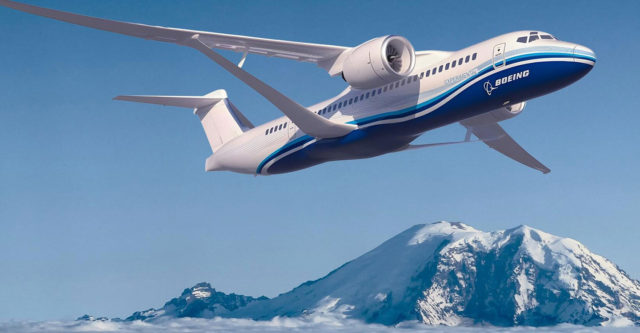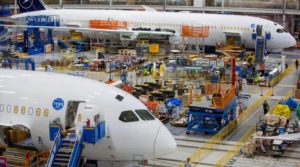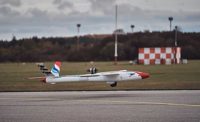The basic design of commercial airplanes hasn’t changed much in decades. Companies such as Airbus and Boeing have traditionally relied on a wing-and-tube configuration, where wings are attached underneath the fuselage. But, engineers are now studying the pros and cons of an old idea where the wing is located above the fuselage.
Extra-long, thin wings stabilized by diagonal struts could make future commercial airliners lighter than traditional designs. When combined with expected advancements in propulsion systems, materials and systems architecture, a single-aisle airplane equipped with a transonic truss-braced wing (TTBW) could reduce fuel consumption and emissions by up to 30 percent.
The concept has piqued the interest of aerospace engineers in Europe and the United States looking for new ways to improve the efficiency and sustainability of midsized aircraft, the workhorse of airlines worldwide.
Boeing and NASA are developing a TTBW design that features two jet engines and a high “T” tail. Meanwhile, a team at ONERA, the French national aerospace research center, is working on a plane that uses a pair of open-rotor engines fueled by hydrogen.
Diagonal struts used in both designs support the long wings and help add lift. The unique shape of the wings creates less drag in the air. That would enable a plane to burn less fuel than an aircraft equipped with a traditional wing design.
According to Greg Hyslop, chief engineer and executive vice president of engineering, test and technology at Boeing, “ultrathin wings braced by struts with larger spans and higher-aspect ratios could eventually accommodate advanced propulsion systems that are limited by a lack of underwing space in today’s low-wing airplane configurations.”
The idea of using high wings equipped with struts is not new. In the early 1950s, a French manufacturer called Hurel-Dubois produced the HD.31 airplane. It featured a high-aspect ratio design with a 150-foot wing that was more than twice the length of its fuselage.
In the U.S., Werner Pfenninger, Ph.D., a leading expert on laminar flow control technology, proposed a TTBW concept in the mid-1950s. In 1979, he also sketched a design for a jumbo-sized transport aircraft equipped with four jet engines and a 420-foot truss-supported wing.
And, in the mid-1990s, engineers at Virginia Tech University studied a long-haul jet similar to a Boeing 777 that featured truss-supported wings and tip-mounted engines. The objective of the project was to minimize the take-off gross weight of jetliners.
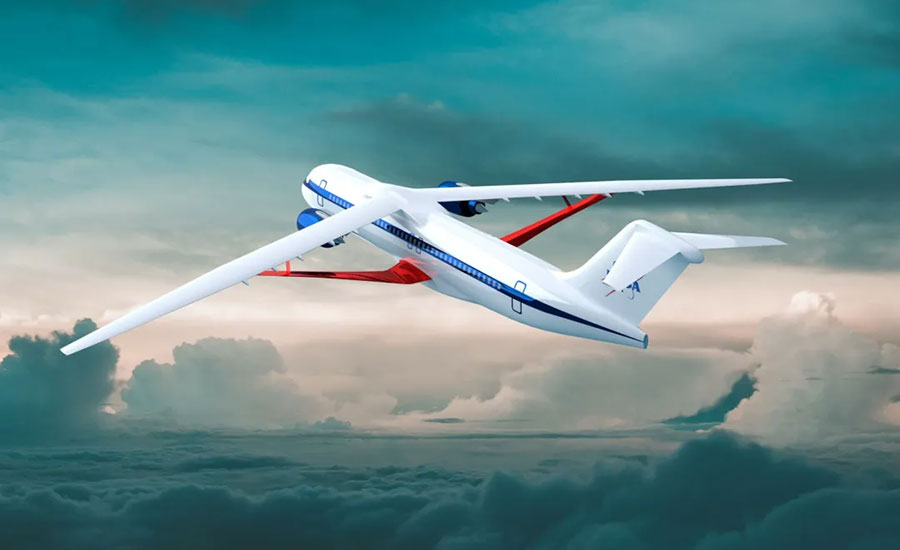
A single-aisle airplane equipped with a transonic truss-braced wing could reduce fuel consumption and emissions by up to 30 percent. Illustration courtesy NASA
At the recent Paris Air Show, ONERA displayed a model of its Gullhyver concept. The 200-seat aircraft features a double-bubble cross section and an upward-sloped nose to generate lift.
The thin wing has an aspect ratio of 20, which is twice as much as current short- and medium-range commercial aircraft. The configuration is being evaluated as part of the EU’s U-Harward project, which is studying the pros and cons of truss-braced wings.
Unlike their European counterparts, who are proposing to build an entirely new aircraft, American aerospace engineers plan to modify an existing plane by adding a new center fuselage and wings. They’ve been studying the pros and cons of the concept for more than a decade.
Despite numerous advantages, TTBW airframes pose challenges. For instance, the unconventional configuration leads to complex airflow phenomena, such as transonic buffet, separated flow and a turbulent wake.
Extensive wind tunnel tests have examined these issues. During recent load testing at NASA’s Armstrong Flight Research Center, engineers observed the interaction of a model strut and wing, as well as the forces affecting each.
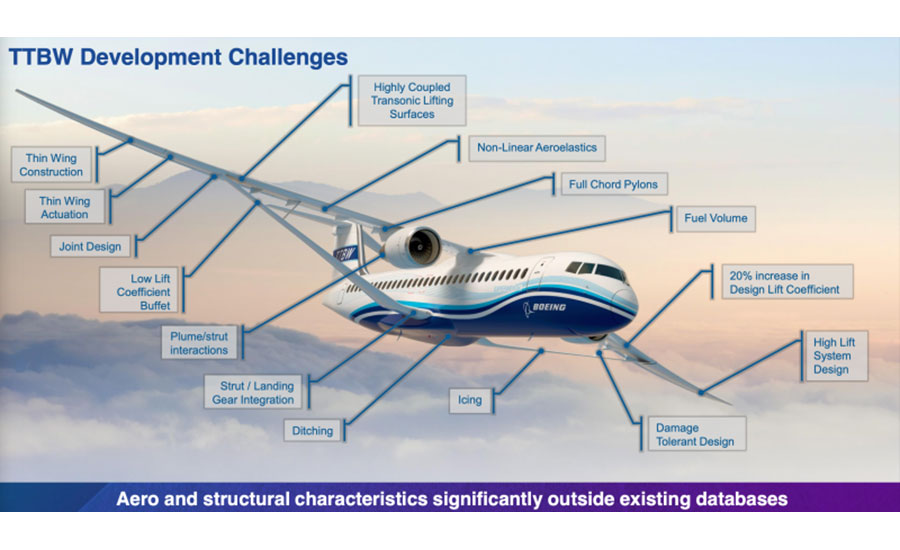
Many challenges still need to be addressed before transonic truss-braced wings become a reality. Illustration courtesy Boeing Commercial Airplanes
They previously had no calculations to estimate how forces transferred from the main wing to the strut. Information gathered from using a six-foot model in the wind tunnel will enable engineers to calculate what will happen when they build a larger wing.
“We identified early that we needed to learn more about how these structures with the strut respond to load and to see what additional information we may need for a calibration of a bigger structure,” says Frank Pena, mock wing test director at the NASA Armstrong Flight Loads Laboratory. “We decided to use the load cell between the strut and the main wing to help us track down some of this missing information that otherwise could not be obtained.”
Pena and his colleagues plan to use the six-foot model data to guide the design of a 10-foot version, in coordination with NASA’s Langley Research Center, which has also been studying the TTBW concept. The larger wing will have a swept-back angle closer to the design developed at Langley.
“It differs from the smaller wing version, which focused on testing instrumentation and methods,” explains Pena. “The larger wing will also have more representative connections between the fuselage and the strut and wing.”
Engineers at NASA’s Ames Research Center recently conducted additional wind tunnel tests using an 11-foot-long half-model equipped with hundreds of sensors. They’re using the data to find the upper limits that the aircraft can perform at—in terms of factors such as speed and altitude—before the vibrations caused by buffet become excessive.
The engineers are using new methods for simulating buffet and air flow to better predict the performance of truss-braced wings. Eventually, they’ll move to more complex TTBW configurations, studying deep stall and high-lift configurations where devices such as slats and flaps are deployed.
Due to the T-tail configuration of the empennage proposed for the TTBW, it may be prone to deep stall, where the turbulent wake from the stalled main wing and strut blankets the tailplane and renders the elevators ineffective, preventing the aircraft from recovering.
Accurately capturing the turbulent wake coming from the main wing and strut of the TTBW, and maintaining the turbulent fluctuations until reaching the tail, will be critical to accurately predicting this behavior.
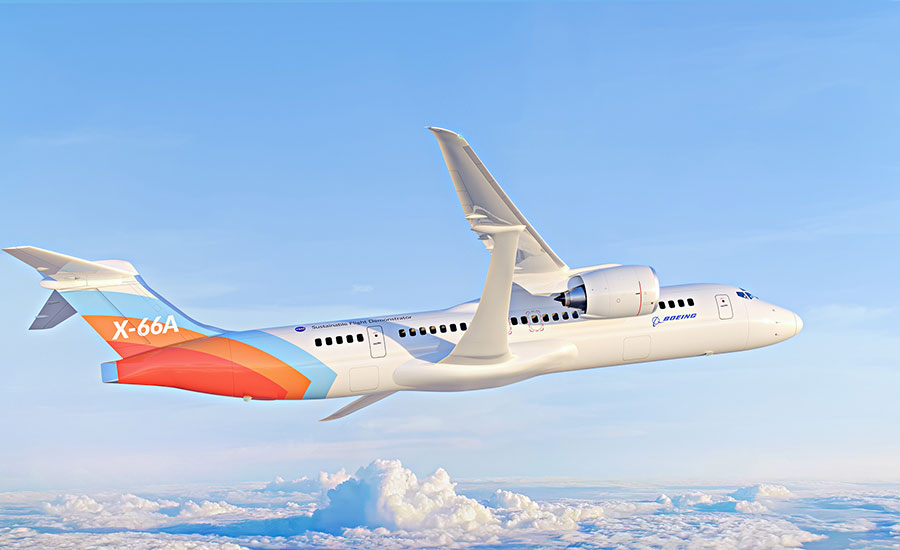
This X-plane will be based on a modified MD-90 jetliner. Illustration courtesy Boeing Commercial Airplanes
The next step in the multiyear development process will be to construct a full-scale prototype aircraft. Technologies tested as part of the sustainable flight demonstrator (SFD) program will inform future designs and could lead to new breakthroughs in aerodynamics and fuel efficiency gains.
“The SFD program has the potential to make a major contribution toward a sustainable future,” claims Hyslop. “It represents an opportunity to design, build and fly a full-scale experimental plane, while solving novel technical problems.
For the demonstrator vehicle, Hyslop and his colleagues plan to use elements from existing aircraft and integrate them with all-new components. They recently took delivery of a former Delta Air Lines MD-90. It will be modified with a 145-foot truss-braced wing, which will be 50 percent longer than the cantilever wing used on traditional single-aisle airplanes such as the Boeing 737. Test flights will be conducted at the Armstrong Flight Research Center later this decade.
Boeing envisions a future family of TTBW aircraft that would enter service in the 2030s. The VS-1 would seat 130 to 160 passengers, while the larger VS-2 would feature 180 to 210 seats. The latter model would sport a bigger wing and engines. Folding wing tips would help the aircraft adapt to existing airport infrastructure, especially facilities that have tight space.
“How this type of aircraft could fit within existing airports would be a big challenge,” says George “Nick” Bullen, an internationally recognized expert on aircraft manufacturing. “A lot of airports have space constraints and collisions with ground support equipment are already a problem. The struts would add an additional element of danger.”
Extra infrastructure burden on airports has doomed some aircraft in the past, such as the Airbus A380. While Bullen says the TTBW concept is interesting, he believes that it may never become commercially viable, just like other jaw-dropping designs from the past, such as Boeing’s Sonic Cruiser prototype from two decades ago.
“The use of struts will stabilize the wings and provide some extra lift, which allows for better efficiency,” explains Bullen. “You don’t have as much drag, because you don’t have as much surface area for the wing to run across.
“However, there are many challenges associated with using a radical concept and a new type of wing structure,” warns Bullen. “Elasticity and flutter can be liabilities on long, thin wings. And, engineers will have to figure out new ways to store fuel, mount engines to wings and mount landing gear to struts.
“To save weight, I assume that the wing would be made out of composite materials,” notes Bullen. “The length and thinness of the wing could present manufacturing issues. There also could be challenges attaching the wing and truss to the fuselage.”
